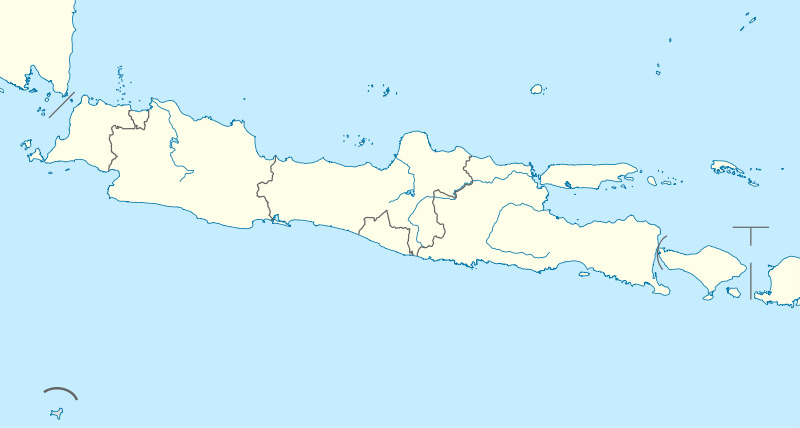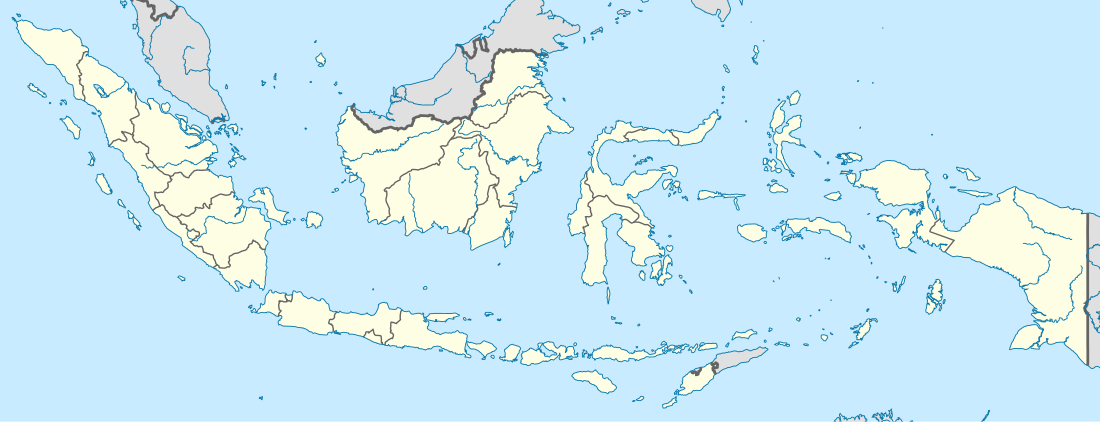Surakarta
Surakarta (Javanese: ꦯꦸꦫꦏꦂꦠ), known colloquially as Solo, is a city in Central Java, Indonesia. The 46 km2 (16.2 sq mi) city[2] adjoins Karanganyar Regency and Boyolali Regency to the north, Karanganyar Regency and Sukoharjo Regency to the east and west, and Sukoharjo Regency to the south.[3] On the eastern side of Solo lies Solo River (Bengawan Solo). Its built-up (or metro) area made of Surakarta Municipality and 59 districts spread on 7 regencies was home to 3,649,254 inhabitants as of 2010 census.[4]
Surakarta Solo | |
|---|---|
| Other transcription(s) | |
| • Javanese | ꦯꦸꦫꦏꦂꦠ |
| • Chinese | 梭罗 |
 Clockwise: Skyline of Solo, Omah Sinten, Pura Mangkunagaran, Sriwedari, Windujenar Market | |
 Seal | |
| Motto(s): The Spirit of Java | |
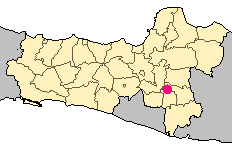 Location within Central Java | |
| Coordinates: 7°34′0″S 110°49′0″E | |
| Country | |
| Province | |
| Government | |
| • Sunan | Pakubuwana XIII |
| • Duke | Mangkunegara IX |
| • Mayor | F. X. Hadi Rudyatmo |
| • Vice Mayor | Achmad Purnomo |
| Area | |
| • City | 46.01 km2 (17.76 sq mi) |
| • Metro | 2,658.3 km2 (1,026.4 sq mi) |
| Elevation | 92 m (302 ft) |
| Population (2010 census) | |
| • City | 499,337 |
| • Density | 11,000/km2 (28,000/sq mi) |
| • Metro | 3,649,254 |
| Time zone | UTC+7 (Indonesia Western Time) |
| Area code | (+62) 271 |
| Vehicle registration | AD |
| Website | surakarta |
Surakarta is the birthplace of the current President of Indonesia, Joko Widodo. He served as Mayor of Surakarta from 2005 to 2012.
Administrative division
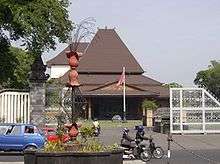
Surakarta City and its surrounding regencies, Karanganyar, Sragen, Wonogiri, Sukoharjo, Klaten, and Boyolali, are collectively called the ex-Surakarta Residency (Dutch: Residentie Soerakarta). After Surakarta became a city, it was divided into five districts (kecamatan), each led by a camat, and subdivided into 51 kelurahan, each led by a lurah. The districts of Surakarta are:[5]
- Kecamatan Pasar Kliwon (Postal code: 57110): 9 kelurahan
- Kecamatan Jebres (Postal code: 57120): 11 kelurahan
- Kecamatan Banjarsari (Postal code: 57130): 13 kelurahan
- Kecamatan Laweyan (also spelled Lawiyan, Postal code: 57140): 11 kelurahan
- Kecamatan Serengan (Postal code: 57150): 7 kelurahan
Greater Surakarta
Surakarta as a dense core city in Central Java, and its second city, spills considerably into neighboring regencies. Though a traffic study quotes the population as 1,158,000 as of 2008,[6] this reflects only the very core, as the city affects entire neighboring regencies by significantly driving up overall population densities in Sukoharjo Regency and Klaten Regency over the already dense countryside. Furthermore, the government of Indonesia officially defines a broader region as Surakarta's extended metropolitan zone, with the acronym Subosukawonosraten as the city and 6 surrounding regencies.,[7][8] though obviously not a core metropolitan area as some of its regencies are not particularly suburbanized, it reflects a broader planning region. Both the metropolitan area and extended areas border Yogyakarta's metropolitan area, while only the extended metropolitan area borders Kedungsapur or Greater Semarang.
| Administrative division | Area (km²) | Population (2010 Census) | Population density (/km²) |
|---|---|---|---|
| Surakarta Municipality | 44.03 | 499,337 | 11,340 |
| Sukoharjo Regency | 466.66 | 824,238 | 1,766 |
| Klaten Regency | 655.56 | 1,130,047 | 1,723 |
| Boyolali Regency | 1,015.1 | 930,531 | 916 |
| Sragen Regency | 946.49 | 858,266 | 906 |
| Karanganyar Regency | 800.28 | 813,196 | 1,016 |
| Wonogiri Regency | 1,822.37 | 928,904 | 509 |
| Greater Surakarta (Subosukawonosraten) | 5,750.49 | 5,984,519 | 1,040 |
Demography
One of the earliest censuses held in Surakarta Residency (Residentie Soerakarta) was in 1885. At that time, with an area of about 5,677 km² (2191.9 sq mi), there were 1,053,985 people in Surakarta Residency, including 2,694 Europeans and 7,543 Indonesian-Chinese. The area, 130 times the current area of Surakarta, had a population density of 186 people/km² (480/sq mi). The capital of the residency itself (roughly the size of the City of Solo proper) in 1880 had 124,041 people living in it.[9]
According to the 2009 census, there were 245,043 males and 283,159 females (a sex ratio of 86.54) in Surakarta.[10] 119,951 of the population were 14 years or younger, 376,180 were between 15 and 64, and 32,071 were above 65.[11] The number of households was 142,627 and the average number of household members was 3.7.[12] The population growth in the last 10 years was about 0.565% per year.[13]
The labor force of Solo in 2009 was 275,546, of whom 246,768 were working, while 28,778 were seeking work. Another 148,254 people aged 15 and above were not in the labor force.[14] Based on employment numbers, the most common work in Solo was worker/paid employee (112,336), followed by self-employee (56,112), self-employee assisted by temporary employee (32,769), unpaid employee (20,193), self-employee assisted by permanent employee (14,880), freelance employee in non-agricultural work (10,241), and freelance employee in agricultural work (237).[15] Based on the industry, most people in Solo worked in trade (106,426), services (59,780), manufacturing (42,065), communication (16,815), construction (9,217), financing (9,157), or agriculture (2,608), and the rest in mining, electricity, gas, and water companies (700).[16]
The mean working week in Solo was 47.04 hours (47.74 for men and 46.13 for women),[17] and 212,262 people worked more than 35 hours per week compared to 34,506 who worked less than that.[18]
Education
According to 2009 statistics, 242,070 people above 15 in the city had finished high school, while 86,890 had only finished junior high school, and 94,840 were still in school or had only finished elementary school. The percentage of high-school graduates was the highest of the cities and regencies in Central Java.[19]
According to the statistics of Data Pokok Pendidikan (Dapodik), in the 2010/2011 school year, there were 68,153 students and 853 schools in Surakarta.[20] There are two big universities possessing more than 20.000 students: Sebelas Maret University (UNS) and Muhammadiyah University of Surakarta (UMS), both are recognised as among Indonesia's 50 best universities according to the Directorate of Higher Education, Ministry of Education RI. There is also arts concentrated university Art Institute of Surakarta (ISI), religious studies State Islamic Institute (IAIN Surakarta). There are around 52 private universities and colleges such as STIKES Muhammadiyah, Universitas Tunas Pembangunan, Universitas Slamet Riyadi, Universitas Surakarta, Universitas Setia Budi etc.[21]
Economy
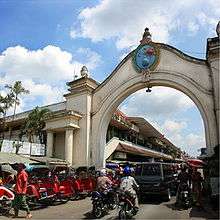
The per capita GDP of Surakarta in 2009 was 16,813,058.62 IDR, the fourth highest in Central Java after Kudus, Cilacap, and Semarang.[22] The living standard in 2009 was 723,000 IDR.[23] The Consumer price index in January 2011 was 119.44.[24]
Sports
Surakarta has a long sport history and tradition. In 1923 Solo already had a football club, one of the earliest clubs in Indonesia (at that time still the Dutch Indies), called Persis Solo. Persis Solo was a giant club in the Dutch Indies and still exists, but is past its heyday. During the Perserikatan tournament, Persis became seven-time champion. Currently it plays in the Liga 2 Indonesia. Other than Persis, several clubs have existed in Solo: Arseto, Pelita Solo, Persijatim Solo FC, and lastly Solo FC played in the Indonesian Premier League in 2011. Both clubs that still exist, Persis and Solo FC, have made Manahan Stadium their home ground. Manahan Stadium is one of the best sports stadiums in Central Java, with more than 25,000 seats, and has several times hosted national and international matches. It was recently the venue for the AFC Champions Cup 2007, the final venue of the Indonesian Cup 2010, and the opening venue for the Indonesian Premiere League on January 15, 2011.[25]
Disabled Sports
Surakarta has hosted the first National Paralympic Games (Pekan Paralimpiade Nasional) in 1957 and hosted several of the subsequent games. As a result, Surakarta has sport facilities sufficient for holding international disabled sports games.[26]
In 1986, Surakarta hosted the 4th FESPIC Games, making the games the first in Indonesian para-sport history in which international disabled sports games were held.[27] The city is also the host city of the 2011 ASEAN Para Games, instead of Jakarta and Palembang, where the main games were held.[28]
Transportation
Air
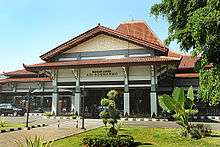
Adisumarmo International Airport (IATA code: SOC) has direct flights to Kuala Lumpur by Malaysia Airlines and during the hajj season, Saudi Arabia, as well as regular flights to Jakarta by Garuda Indonesia, Sriwijaya Air, Lion Air and Citilink. The airport is located 14 km (8.7 mi) north of the city.[29] Since May 2011, BST Batik Solo Trans buses connect the airport to the city. There is also taxicab service. In 2009 Adisumarmo had 2,060 outbound domestic flights and 616 outbound international flights.[30]
Train
Surakarta has four train stations, Solo Balapan, Purwosari, Solo Jebres, and Solo Kota (Sangkrah). Solo Balapan is the largest station in Surakarta, and is the junction between Yogyakarta (westward), Semarang (northward), and Surabaya (eastward), while Purwosari is the junction located west of Solo Balapan, and has a connection to Wonogiri (southward). There are several direct lines to other cities, such as Jakarta, Bandung, Surabaya, Semarang, Madiun, and Malang. For regional traffic, a special train Prameks connects Surakarta, Yogyakarta, and Purworejo Regency.
In 26 July 2011 the Bathara Kresna Rail Bus has been launched to serve Purwosari–Wonogiri route, but for the moment only Purwosari-Sukoharjo trackage was ready due to there are 99 bridges should be strengthen between Sukoharjo-Wonogiri.[31] Until April 2012, Surakarta-Wonogiri railbus is still in a big question mark due to the 12 tons railbuses are considered too heavy for existing railroad track that only has the capacity of accommodating 10-ton vehicles, furthermore PT KAI have proposed a fare between Rp30,000 ($3.27) and Rp40,000 ($4.36) per passenger, while Surakarta administration wants tickets to be priced much lower between Rp5,000 ($0.54) and Rp7,000 ($0,76).[32]
Road

Tirtonadi Terminal is the largest bus terminal in Surakarta. Surakarta is situated on Indonesian National Route 15, which connects it to Yogyakarta and Waru (Sidoarjo). Semarang–Solo Toll Road connects the city with provincial capital Semarang. In 2009 the total extent of roadways in the city was 705.34 km: 13.15 km state road, 16.33 km province road, and 675.86 km local road.[33] The number of bus companies was 23, and the total number of buses operating was 1,115 intra-provincial buses and 1,107 inter-provincial.[34]
In 2010, the government of Surakarta launched a new bus service named Batik Solo Trans (BST), which resembles TransJakarta bus rapid transit service. As of 2017, it has only three routes. A single trip costs Rp.3000, Rp.1500 for students. A special ticket for the trip from or to the airport costs Rp.7000.[35]
Hydrogeology
The water sources for Surakarta are in the valley of Merapi, a total of 19 locations, with a capacity of 3,404 l/second (899.2 U.S. gal/sec). The average source water height is 800–1,200 m (2624.7 ft to 3937 ft) above sea level. In 1890–1927 there were only 12 wells in Surakarta. Today, underground water wells in 23 locations produce about 45 l/second (11.9 U.S. gal/sec).[36]
In March 2006, Surakarta's state water company (PDAM) had a production capacity of 865.02 l/second (228.5 U.S. gal/sec): from Cokrotulung, Klaten, 27 km (16.8 mi) from Solo, 387 l/s (102.2 U.S. gal/sec); and from 26 deep wells, with a total capacity of 478.02 l/second (126.3 U.S. gal/sec). The total reservoir capacity is 9,140 m3 (,414,533 U.S. gala) nd can serve 55,22% of the population.[37]
Climate
Under the Köppen climate classification, Surakarta features a tropical monsoon climate. The city has a lengthy wet season spanning from October through June, and a relatively short dry season covering the remaining three months (July through September). On average Surakarta receives just under 2200 mm (86.6 in) of rainfall annually, with its wettest months being December, January, and February. As is common in areas featuring a tropical monsoon climate, temperatures are relatively consistent throughout the year. Surakarta's average temperature is roughly 30 °C every month (86 °F).
| Climate data for Surakarta, Central Java, Indonesia | |||||||||||||
|---|---|---|---|---|---|---|---|---|---|---|---|---|---|
| Month | Jan | Feb | Mar | Apr | May | Jun | Jul | Aug | Sep | Oct | Nov | Dec | Year |
| Average high °C (°F) | 30.1 (86.2) |
30.2 (86.4) |
30.5 (86.9) |
31.4 (88.5) |
31.1 (88.0) |
31.1 (88.0) |
30.9 (87.6) |
31.6 (88.9) |
32.4 (90.3) |
32.9 (91.2) |
31.7 (89.1) |
30.9 (87.6) |
31.2 (88.2) |
| Daily mean °C (°F) | 26.2 (79.2) |
26.3 (79.3) |
26.4 (79.5) |
26.9 (80.4) |
26.5 (79.7) |
25.9 (78.6) |
25.4 (77.7) |
25.7 (78.3) |
26.6 (79.9) |
27.4 (81.3) |
26.9 (80.4) |
26.6 (79.9) |
26.4 (79.5) |
| Average low °C (°F) | 22.3 (72.1) |
22.4 (72.3) |
22.3 (72.1) |
22.4 (72.3) |
21.9 (71.4) |
20.8 (69.4) |
20.0 (68.0) |
19.9 (67.8) |
20.9 (69.6) |
21.9 (71.4) |
22.2 (72.0) |
22.3 (72.1) |
21.6 (70.9) |
| Average precipitation mm (inches) | 324 (12.8) |
318 (12.5) |
306 (12.0) |
214 (8.4) |
145 (5.7) |
86 (3.4) |
52 (2.0) |
42 (1.7) |
51 (2.0) |
120 (4.7) |
212 (8.3) |
260 (10.2) |
2,130 (83.7) |
| Source: climate-data.org[38] | |||||||||||||
Tourism
.jpg)
One main tourist attraction of Surakarta is the Keraton Surakarta, the palace of Susuhunan Pakubuwono, also the Princely Javanese court of Mangkunegaran. Pasar Gede market is often visited by tourists, mostly for its unique architecture and fame as the biggest traditional market in the Solo area. The Pasar Klewer is famous for its batiks in all prices and qualities, while the Pasar Triwindhu located near Mangkunegaran palace specialises in antiques. Taman Sriwedari is a popular local entertainment park featuring a children's playground, dangdut music performance and Wayang Wong traditional Javanese dance performance almost every night. Near the park is Radyapustaka Museum, one of the oldest museums in Indonesia, with a collection of Javanese cultural artefacts. The traditional batik village of Laweyan and Kampung Batik Kauman, located in the southwest part of the city and the city centre respectively, are famous for producing fine quality Javanese batik.
Within Surakarta tourists can also use the Jaladara old steam train which was launched on in September 2009 for 5.6 km connecting Purwosari Station and Solo Kota Station. In 2011 there were 60 trips and in 2012 will be 80 trips.[39]
People from Surakarta
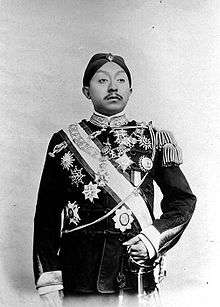
- Agung Setyabudi, football player
- Basuki, actor and comedian
- Diah Permatasari, actress and model
- Didi Kempot, singer
- F. X. Hadi Rudyatmo, current mayor of Surakarta
- Gesang, singer-songwriter
- Icuk Sugiarto, former badminton player
- Joko Suprianto, former badminton player
- Joko Widodo, former Mayor of Surakarta, Governor of Jakarta and the current President of Indonesia
- Pakubuwono X, 9th monarch of Surakarta Sunanate, one of National Hero of Indonesia
- Rio Haryanto, Indonesia's first Formula One driver
- Rudy Gunawan, former badminton player
- Sapardi Djoko Damono, poet
- Siti Hartinah, wife of the second Indonesian president, Suharto
- Suryo Agung Wibowo, sprinter
- Waldjinah, singer
- Widji Thukul, poet
- Wynne Prakusya, former tennis player
Sister cities
References
- "BPS Provinsi Jawa Tengah". jateng.bps.go.id. Retrieved October 8, 2018.
- (in Indonesian) Badan Pusat Statistik: Luas Daerah menurut Kabupaten/Kota di Provinsi Jawa Tengah Tahun 2009 Archived August 18, 2011, at the Wayback Machine
- (in Indonesian) Map of Surakarta
- "Indonesia: Java (Regencies, Cities and Districts) - Population Statistics in Maps and Charts". www.citypopulation.de.
- (in Indonesian) Kecamatan dan Desa/Kelurahan menurut Kabupaten/Kota di Provinsi Jawa Tengah Tahun 2005, 2008 dan 2009 Archived August 18, 2011, at the Wayback Machine
- http://www.cdia.asia/sharedfiles/PFS%20Training%20for%20NPOs%20presentations/Day%203/Surakarta%20Transport%20PFS%20Executive%20Summary.pdf%5B%5D
- http://jurnal.pdii.lipi.go.id/admin/jurnal/131102025_1410-9409.pdf%5B%5D
- "Archived copy". Archived from the original on May 21, 2013. Retrieved January 7, 2014.CS1 maint: archived copy as title (link)
- (in German) Seite aus Meyers Konversationslexikon: Suppeditieren – Surate: Surakarta
- "Population of Jawa Tengah by Regency/City and Sex 2009". Archived from the original on December 4, 2010. Retrieved March 19, 2011.
- "Population of Jawa Tengah by Regency/City and Age Group 2009". Archived from the original on December 18, 2010. Retrieved March 19, 2011.
- "Number of Households and Average of Household Member by Regency/City in Jawa Tengah 2009". Archived from the original on December 20, 2010. Retrieved March 19, 2011.
- (in Indonesian) PDAM Solo: Profil Archived February 8, 2009, at the Wayback Machine
- "Population Aged 15 Years and Over by Regency/City and Type of Activity during The Previous Week and Sex in Jawa Tengah 2009". Archived from the original on December 26, 2010. Retrieved March 19, 2011.
- "Population Aged 15 Years and Over who Worked during for The Previous Week by Regency/City and Employment Status in Jawa Tengah 2009". Archived from the original on December 26, 2010. Retrieved March 19, 2011.
- "Population Aged 15 Years and Over who Worked by Regency/City and Main Industry in Jawa Tengah 2009". Archived from the original on December 28, 2010. Retrieved March 19, 2011.
- "Working Hours Rate during the Previous Week by Regency/City and by Sex in Jawa Tengah 2009". Archived from the original on December 20, 2010. Retrieved March 19, 2011.
- "Population Aged 15 Years and Over who Worked during a Week by Regency/City and Time of Work in Jawa Tengah 2009". Archived from the original on December 20, 2010. Retrieved March 19, 2011.
- "Population Aged 15 Years and Over by Regency/City by Education Attainment in Jawa Tengah 2009". Archived from the original on December 26, 2010. Retrieved March 19, 2011.
- "Archived copy". Archived from the original on June 21, 2011. Retrieved March 30, 2011.CS1 maint: archived copy as title (link)
- (in Indonesian) Daftar universitas swasta di Surakarta Archived August 30, 2011, at the Wayback Machine
- (in Indonesian) PDRB PERKAPITA ATAS DASAR HARGA BERLAKU MENURUT KABUPATEN/KOTA JAWA TENGAH TAHUN 2005–2009 (RUPIAH) Archived August 18, 2011, at the Wayback Machine
- "Value of Worker Proper Life Requirement and Regency/City Minimum Wage by Regency/City in Jawa Tengah 2007 – 209 (Rupiahs)". Archived from the original on December 20, 2010. Retrieved March 19, 2011.
- (in Indonesian) Indeks Harga Konsumen dan Inflasi Di 66 Kota ( 2007=100 ) 2011 Archived December 22, 2010, at the Wayback Machine
- Post, The Jakarta. "Editorial: Welcome LPI".
- Pramudiano, Yuli Leni (November 1, 2016). "Wisma Atlet Penyandang Cacat di Surakarta" (PDF): 1. Cite journal requires
|journal=(help) - "Saat Penutupan Cikal Bakal Asian Para Games pada 1986 Diguyur Hujan." MSN (in Indonesian). Retrieved December 13, 2018.
- "Solo Siap Jadi Tuan Rumah ASEAN Para Games". Kementrian Pemuda dan Olahraga Republik Indonesia. March 15, 2011. Retrieved November 5, 2018.
- Adi sumarmo International Airport Solo, Asiarooms.com, Retrieved July 25, 2010
- (in Indonesian) Arus Lalu Lintas Pesawat Udara Komersial Menurut Bandar Udara di Jawa Tengah Tahun 2009 (Trip)
- "Solo-Wonogiri Railbus".
- "Surakarta's 'railbuses' are too heavy for tracks: KAI". April 13, 2012.
- (in Indonesian) Panjang Jalan Negara, Jalan Propinsi dan Kabupaten/Kota di Jawa Tengah Tahun 2009 (Km) Archived August 18, 2011, at the Wayback Machine
- (in Indonesian) Banyaknya Perusahaan Bus Umum AKDP/AKAP menurut Kabupaten/Kota di Jawa Tengah Tahun 2009 Archived August 18, 2011, at the Wayback Machine
- "Batik Solo Trans. Portal Informasi Kota Surakarta". Archived from the original on February 4, 2011. Retrieved May 1, 2011.
- PDAM Solo: The Greater Surakarta
- (in Indonesian) Produksi air
- "Climate Surakarta: Temperature, Climate graph, Climate table for Surakarta - Climate-Data.org". en.climate-data.org.
- "Asyiknya Menikmati Kota Solo dengan Kereta Uap Jaladara". April 10, 2012.
- "Surakarta dan Montana, Bulgaria Menjadi Kota Kembar". Portal Nasional Republik Indonesia. October 21, 2007. Retrieved January 25, 2010.
Further reading
- Majeed, Rushda. "The City With a Short Fuse." Foreign Policy. September 2012.
- Majeed, Rushda. "Defusing a Volatile City, Igniting Reforms: Joko Widodo and Surakarta, Indonesia, 2005-2011." Innovations for Successful Societies. Princeton University. Published July 2012.
- Miksic, John (general ed.), et al. (2006) Karaton Surakarta. A look into the court of Surakarta Hadiningrat, central Java (First published: 'By the will of His Serene Highness Paku Buwono XII'. Surakarta: Yayasan Pawiyatan Kabudayan Karaton Surakarta, 2004) Marshall Cavendish Editions Singapore ISBN 981-261-226-2
- Soeharto, G. Dwipayana dan Ramadhan K.H. "Ucapan, Pikiran dan Tindakan Saya". 1988. PT Citra Lamtoro Gung.
- Miksic, John (general ed.), et al. (2006) Karaton Surakarta. A look into the court of Surakarta Hadiningrat, central Java (First published: 'By the will of His Serene Highness Paku Buwono XII'. Surakarta: Yayasan Pawiyatan Kabudayan Karaton Surakarta, 2004) Marshall Cavendish Editions Singapore ISBN 981-261-226-2
- Soeharto, G. Dwipayana dan Ramadhan K.H. "Ucapan, Pikiran dan Tindakan Saya". 1988. PT Citra Lamtoro Gung.
- Paku Buwono XII (Sunan of Surakarta), A. Mutholi'in, "Karaton Surakarta", Yayasan Pawiyatan Kabudayan Karaton Surakarta, 2004
- Nancy K. Florida, Javanese literature in Surakarta manuscripts / Vol. 1 Introduction and manuscripts of the Karaton Surakarta, Cornell University, Ithaca, N.Y. Southeast Asia Program (SEAP), 1993.
- Nancy K. Florida, Javanese literature in Surakarta manuscripts / Vol. 2 Manuscripts of the Mangkunagaran Palace, Cornell University Ithaca, NY : Southeast Asia Program (SEAP), 2000.
- Nancy K. Florida, "Writing the past, inscribing the future: history as prophesy in colonial Java", Duke University Press, 1995
- Richard Anderson Sutton, "Traditions of gamelan music in Java: musical pluralism and regional identity", CUP Archive, 1991
- Clara Brakel-Papenhuijzen, "Classical Javanese dance: the Surakarta tradition and its terminology", KITLV Press, 1995
- The domestication of desire: Women, wealth, and modernity in Java (1998) Brenner, Suzanne April. Princeton, N.J.: Princeton University Press.
- Keraton and Kumpeni: Surakarta and Yogyakarta, 1830–1870 (1994) Houben, V. J. H.. Leiden: KITLV Press.
- Prelude to revolution: Palaces and politics in Surakarta, 1912–1942 (1987) Larson, George D.. Dordrecht, Holland and Providence, R.I., U.S.A.: Foris Publications.
- Solo in the new order: Language and hierarchy in an Indonesian city (1986) Siegel, James T.. Princeton, N.J.: Princeton University Press.
- Pakubuwono's keraton of Surakarta: Short guide to Surakarta's grandeur : the palace of the Susuhunans Pakubuwono (1980) No contributors listed. Jakarta: Proyek Pengembangan Sarana Wisata Budaya Jakarta.
- Miftah Sanaji, "Wisata Kuliner Makanan Daerah Khas Solo", Gramedia 2009, ISBN 978-979-22-5209-5
- "Ekspedisi Bengawan Solo", Laporan Jurnalistik Kompas, Kompas 2009, ISBN 978-979-709-390-7
- Linda Carolina Brotodjojo, "Jajanan Kaki Lima Khas Solo", Gramedia 2008, ISBN 978-979-22-4143-3
- Izharry Agusjaya Moenzir, "Gesang", Gramedia 2010, ISBN 978-979-22-5911-7
External links
| Wikimedia Commons has media related to Surakarta. |
| External media | |
|---|---|
| Images | |
| Video | |

- Official website of the government of Surakarta
- Solo City General Forum – Visitors' Guide and many pictures.
- Military History Centre – "Serangan Oemoem" (August 7, 1949).
- JalanSolo.com – Jalan Solo – the Spirit of JAVA
- Interactive map, information on places of interest and accommodations
- Solo Flooring Craft Industry - Solo Handcraft Flooring Industry
- Solo Business Directory

- . New International Encyclopedia. 1905.
